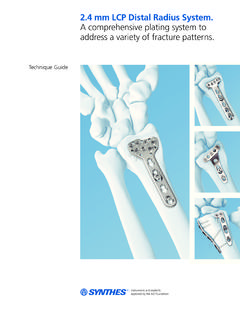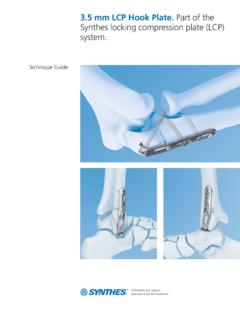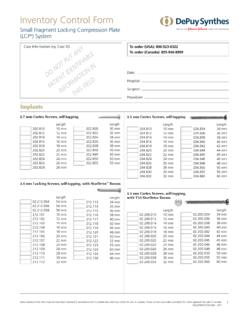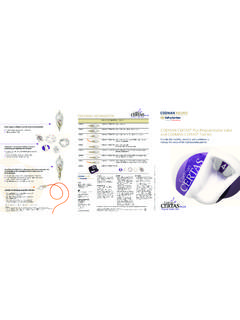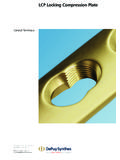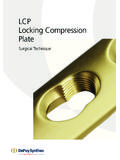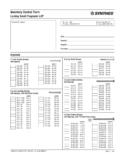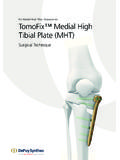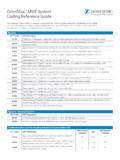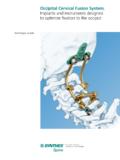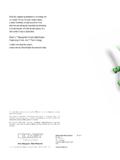Transcription of Small Fragment Locking Compression Plate (LCP) …
1 Small Fragment LockingCompression Plate (LCP) steel and GuideIntroductionSurgical TechniqueProduct InformationTable of ContentsSmall Fragment Locking Compression Plate (LCP) System2AO Principles4 Indications5 fixation Principles6 Preparation11 Reduction and Temporary Plate Placement12 Screw Insertion13 Screw Placement Verification17 Postoperative Treatment19 Implant Removal19 Implants20 Instruments24 Set List31 Image intensifier Fragment Locking Compression Plate (LCP) SystemThe aim of any surgical fracture treatment is to reconstruct the anatomy and restore its function. According tothe AO, internal fixation is distinguishedby precise reduction, stable fixation ,preservation of blood supply and early,functional mobilization.
2 Plate and screwosteosynthesis has been established andclinically recognized for quite sometime. Clinical results have been improvedby using internal fixation with angularstability (internal fixators) in metaphysealfractures and in osteopenic Synthes Locking Compression Plate (LCP) is part of a stainless steel and titanium Plate and screw system thatmerges Locking screw technology withconventional plating techniques. TheLocking Compression Plate system hasmany similarities to existing Plate fixationmethods, but with a few important improvements. Locking screws providethe ability to create a fixed-angle construct while utilizing familiar AOplating techniques. A fixed-angle con-struct provides advantages in osteopenicbone or multifragmentary fractureswhere traditional screw purchase iscompromised.
3 Locking screws do notrely on Plate /bone Compression tomaintain stability, but function similarlyto multiple Small angled blade featuresThe Locking Compression Plates (LCP)have the following LC-DCP features: 80 of longitudinal screw angulation 14 of transverse screw angulation Uniform hole spacing Load ( Compression ) and neutral screw positionsLocking Compression plates havecombination Locking and compressionholes (Combi holes).The Combi holes allow placement ofstandard cortex and cancellous bonescrews on one side or threaded conical Locking screws on the opposite side ofeach Threaded hole section for lockingscrewsb. Dynamic Compression unit (DCU)hole section for standard screwsc. Locking screw in threaded side of Plate holed.
4 Cortex screw in Compression side of Plate holeNote:Holes in straight and reconstruc-tion plates are oriented so that thecompression component of the hole is always directed toward the middle of the Fragment Locking Compression Plate (LCP) system Technique mm Locking Screws, self-tapping,with StarDrive recessThe mm Locking screws mate withthe threaded Plate holes to form afixed-angle screw designThe screw design has been modified, as compared to standard mm cortex screws, to enhance fixation and facilitate the surgical procedure. Features include:Conical screwheadThe conical head facilitates alignmentof the Locking screw in the threadedplate hole to provide a secure screw / Plate core diameterThe large core diameter improves bendingand shear strength, and distributes theload over a larger area in the bone.
5 Thread profileThe shallow thread profile of the lockingscrews results from the larger core diameter, but is acceptable becauselocking screws do not rely solely on thescrew threads to create compressionbetween the Plate and the bone to maintain stability. Drive mechanismThe StarDrive recess provides improvedtorque transmission to the screw whileretaining the screw without the use of a holding threadsmate with the platesSelf-tapping flutesStarDrive recessCortical thread profile4 SynthesSmall Fragment Locking Compression Plate (LCP) system Technique GuideAO PrinciplesIn 1958, the AO formulated four basic principles, which have become the guidelines for internal principles, as applied to the Small Fragment LCP implants, are.
6 Anatomic reduction Facilitates restoration of the articular surface by exact screwplacement using wire fixationLocking screws create a fixed-angle construct, providing angular of blood supplyTapered end allows submuscular Plate insertion, preserving tissue Plate design reduces Plate -to-bone contact,limiting vascular trauma and insult to , active mobilizationPlate features combined with AO technique create an environment for bone healing, expediting a return to optimal M ller, M. Allg wer, R. Schneider, H. Willenegger: Manual of Internal fixation , 3rd Edition. Berlin; Springer-Verlag. Small Fragment Locking Compression Plates (LCP)are intended for fixation of fractures, osteotomies andnonunions of the clavicle, scapula, olecranon, humerus, radius, ulna, pelvis, distal tibia, and fibula, particularly in osteopenic Fragment Locking Compression Plate (LCP) system Technique GuideFixation PrinciplesThe following points distinguish treatment using lockingscrew technology from conventional plating techniques.
7 It enables fracture treatment using Compression platingwith conventional cortex or cancellous bone screws An LCP Plate can also be used as an internal fixator andpermits stable bridging over shattered zones The LCP system permits the combination of conventionaland Locking screws Unicortical Locking screw permits better vascularityNote:The LCP system applies to many different Plate typesand is therefore suitable for a large number of fracture that reason, this technique guide does not deal with any specific fracture type. Please refer also to the AO Principles of Fracture Management,2and AO Manual of Fracture Management Internal screw fixationBicortical screw fixation has long been the traditionalmethod of compressing a Plate to the bone where friction between the Plate and the bone maintains stability.
8 Screwstability and load transfer are accomplished at two pointsalong the screw: the near and far Locking screws provide stability and load transferonly at the near cortex due to the threaded connection between the Plate and the screw. Screw stability and loadtransfer are accomplished at two points along the screw: the screwhead and near cortex. Because the screw is lockedto the Plate , fixation does not rely solely on the pulloutstrength of the screw or on maintaining friction between the Plate and the Bicortical screws require two (2) cortices to achieve Unicortical screws utilize the locked screw and the near cortex to achieve Thomas P. R edi, et al, ed., AO Principles of Fracture Management, New York:Thieme, M.
9 Wagner and R. Frigg, AO Manual of Fracture Management Internal Fixators,New York: Thieme, following examples show the biomechanical features of conventional plating techniques, locked or bridge platingtechniques, and a combination of platingAbsolute stabilityThe tensile force (F1) originating from tightening the screwspresses the Plate onto the bone (F2). The developing friction (F3)between the Plate and the bone leads to stable Plate ensure absolute stability, the friction resistance must behigher than the axial forces (F4) arising during contouring of the plateThe aim of internal fixation is anatomic reduction, particularlyin articular fractures. Therefore, the Plate must be contouredto the shape of the screwInterfragmentary Compression is accomplished by using a lagscrew.
10 This is particularly important in intra-articular fractureswhich require a precise reduction of the joint surfaces. Lagscrews can be angled in the Plate hole, allowing placement of the screw perpendicular to the fracture Fragment Locking Compression Plate (LCP) system Technique GuidePrimary loss of reductionIn conventional plating, even though the bone fragments are correctly reduced prior to Plate application, fracture dislocation will result if the Plate does not fit the bone. In addition, if the lag screw is not seated perpendicular to thefracture line ( , spiral fracture of the distal tibia), shear forceswill be introduced. These forces may cause loss of loss of reductionUnder axial load, postoperative, secondary loss of reductionmay occur by toggling of the screws.
